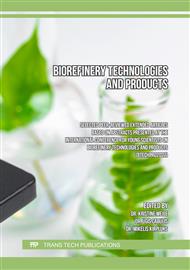p.107
p.116
p.124
p.129
p.139
p.147
p.155
p.162
p.169
The Study of Betulin Particles Containing Hydrogels Prepared by Antisolvent Precipitation
Abstract:
The aim of the study was to investigate the effect of process parameters on the production of hydrogels with antisolvent precipitation using unpurified (UB) and purified (PB) birch outer bark betulin powder samples. Experimental activities are focused on the production of hydrogels using concentration of colloidal dispersions with filtration of UB or PB sample particles obtained by antisolvent precipitation method varying the dilution of saturated (at boiling temperature) ethanol solutions with different water content. During the study the maximum solubility in ethanol at boiling point of PB (22.0 g/L) and UB (55.0 g/L) was determined. For obtaining gel with the highest liquid content (absorption capacity 37.45 g per 1 g of dry matter) from PB by antisolvent precipitation the optimal saturated ethanol solution dilution with water was 12.5 vol%. In the case of UB hydrogel, by dilution of ethanol from 25 to 10 vol%, a gradual decrease of hydrogel dry matter yield and a simultaneous increase of the filtrate dry matter yield can be observed, which is related with leaching of the particles through the filter paper together with a solution and form a colloidal suspension of particles. For obtaining gels with high liquid content from UB the optimal saturated ethanol solution dilution with water was in the range from 20.0 to 12.5 vol% (absorption capacity in average 18 g per 1 g of dry matter). Comparing the chemical compositions of the raw materials and dry matter of hydrogels in the case of PB composition remains quite similar while in UB dry matter composition the betulin content increased from 52 to even 69 wt%. PB at the optimal dilution of 12.5 vol% of ethanol managed to achieve average particle size - 231.7 nm and with UB in the optimal dilution range from 20 to 12.5 vol% the range of average particle size was from 304.7 to 189.8 nm.
Info:
Periodical:
Pages:
139-146
Citation:
Online since:
October 2022
Price:
Сopyright:
© 2022 Trans Tech Publications Ltd. All Rights Reserved
Share:
Citation:



